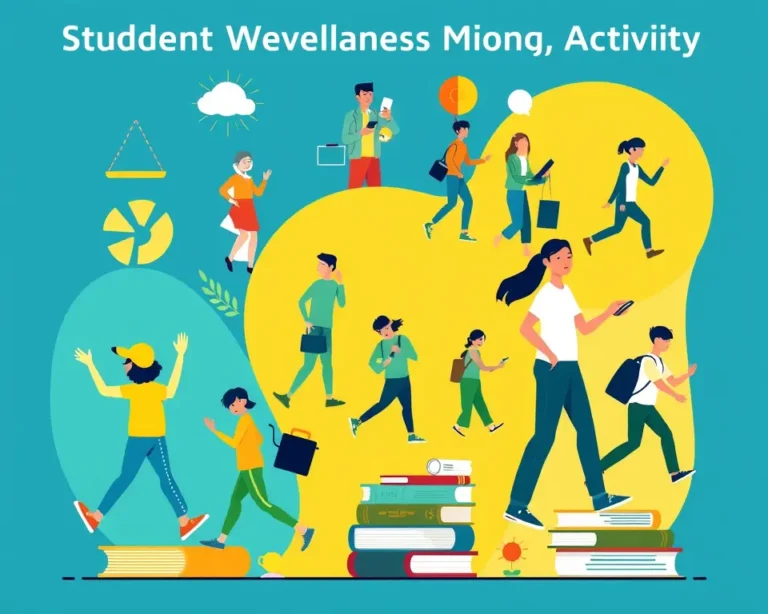Staying active in school is essential for both your mental and physical health, especially with a busy student schedule. Regular exercise can reduce stress, improve your mood, and boost focus, all of which contribute to better academic performance. This article provides simple and affordable fitness tips tailored for students, helping you stay active without breaking the bank or sacrificing study time.
Why Prioritize Fitness in School?
Balancing studies, social life, and personal well-being can be challenging, but integrating fitness into your routine offers numerous benefits.
- Improved Mental Health: Physical activity releases endorphins, natural mood lifters that help manage anxiety and depression, common issues among students. Exercise also boosts memory and thinking skills.
- Enhanced Academic Performance: Regular exercise sharpens problem-solving skills and improves concentration, equipping you to tackle academic challenges and maintain productivity.
- Reduced Stress: College can feel like a pressure cooker, with deadlines and exams causing significant stress. Exercise relieves tension and stress. Physical activity can help reduce restlessness and improve focus.
- Better Physical Health: Exercise reduces the risk of major illnesses such as heart disease, stroke, type 2 diabetes, and certain cancers. It also improves sleep quality.
- Increased Energy Levels: Regular physical activity combats fatigue and increases energy levels, helping you stay active and engaged throughout the day.
Simple and Affordable Fitness Tips
Here are some practical and budget-friendly ways to incorporate fitness into your school life:
1. Integrate Movement into Your Daily Routine
- Walk or Bike to Class: Instead of driving or taking the bus, walk or bike to class. This saves money and adds physical activity to your day.
- Take the Stairs: Always opt for the stairs instead of elevators to strengthen your legs and burn extra calories.
- Use Distant Facilities: Use a bathroom farther from where you’re studying to increase your step count.
2. Quick and Effective Workouts
- Study Break Exercises: Incorporate short bursts of activity during study breaks. Try bodyweight exercises like squats, push-ups, lunges, and planks.
- 15-Minute Full-Body Workout: Even a quick 15-minute workout can make a significant difference. A routine could include:
- Jumping jacks – 1 minute
- Push-ups – 30 seconds
- Plank – 30 seconds
- Bodyweight squats – 1 minute
- Mountain climbers – 1 minute
- Rest – 30 seconds
- Lunges – 1 minute
- Tricep dips (on a chair or bench) – 1 minute
- Plank with shoulder taps – 30 seconds
- High knees – 1 minute
- HIIT Workouts: High-intensity interval training (HIIT) workouts are perfect for busy students. Aim for 20 seconds of intense effort followed by 10 seconds of rest. Repeat the cycle for a fast workout.
- Bodyweight Circuit: Dedicate 10 minutes to a bodyweight circuit, performing each exercise for 30 seconds:
- Jumping Jacks
- Push-ups
- Planks
- Repeat the circuit 2-3 times.
3. Utilize Campus Resources
- Free or Low-Cost Gym Access: Many campuses offer free or low-cost gym access for students. Take advantage of these facilities to stay active without spending much money.
- Fitness Classes: Look for student discounts at local fitness centers or campus-organized fitness classes.
- Intramural Sports: Join intramural sports leagues for a fun way to exercise and socialize with friends.
4. Active Study Sessions
- Combine Study with Exercise: Read or listen to class material while walking on a treadmill or use a stationary bike while reviewing notes.
- Desk Stretches: Incorporate simple exercises while sitting at your desk, such as seated leg raises and shoulder shrugs.
5. Incorporate Fun Activities
- Apartment Room Dance Party: Transform your room into a mini dance floor. Dancing is a great cardio workout and a mood booster.
- Outdoor Activities: Grab a friend and a Frisbee or football, and get outdoors to move around.
- Hiking: Explore hiking trails around campus for a refreshing and active break.
6. Make Fitness Social
- Workout Groups: Form workout groups with friends for a motivating way to stay fit.
- Fitness Buddy: Find a workout buddy with similar fitness goals to plan regular workouts together.
- Join Clubs: Joining clubs and social groups on campus can help you meet new friends and stay active.
7. Prioritize Time Management
- Schedule Workouts: Treat your fitness routine as a non-negotiable part of your day. Identify gaps in your schedule for quick workouts.
- Use a Planner: Keep track of your commitments and allocate time for workouts beforehand.
- Time Blocking: Create time blocks dedicated to fitness goals.
8. Healthy Habits
- Eat Healthy: Maintain a balanced diet to sustain energy levels and support your fitness efforts.
- Stay Hydrated: Keep a water bottle with you and drink water throughout the day.
- Get Enough Sleep: Aim for 7-9 hours of sleep each night to allow your body to recover and function properly.
9. Quick Exercises for Study Breaks
- Stretching: Stretching routines improve flexibility, reduce stress, and prevent injuries.
- Breathing Exercises: Practice deep breathing exercises to calm the mind and reduce stress.
10. Stay Motivated
- Set Achievable Goals: Set small, achievable goals and celebrate your progress.
- Find Enjoyable Activities: Choose activities you enjoy to make exercise more fun and consistent.
- Listen to Your Body: Rest and recovery are as important as exercise. Avoid overtraining.
- Reward Yourself: Give yourself a small, healthy reward when you reach your fitness goals.
Sample Workout Routines
Here are a few sample workout routines you can incorporate into your schedule:
1. 10-Minute Bodyweight Blast
- Jumping Jacks: 30 seconds
- Squats: 30 seconds
- Push-ups: 30 seconds
- Plank: 30 seconds
- Lunges (alternating legs): 30 seconds
- Repeat the circuit twice.
2. Desk Workout
- Seated Leg Raises: 15 reps per leg
- Shoulder Shrugs: 15 reps
- Seated Spinal Twists: 1 minute
- Chair Dips: 10 reps
3. Dorm Room Yoga
- Downward Dog: Hold for 30 seconds
- Child’s Pose: Hold for 30 seconds
- Warrior II: Hold for 30 seconds per side
The Impact of Physical Activity on Learning
Physical activity isn’t just about physical health; it significantly impacts cognitive functions and learning.
- Improved Alertness and Attention: Exercise optimizes your mindset, improving alertness, attention, and motivation.
- Enhanced Nerve Cell Development: It encourages nerve cells to bind together, which is crucial for logging new information.
- New Brain Cell Growth: Exercise spurs the development of new nerve cells from stem cells in the hippocampus, an area of the brain vital for learning and memory.
Overcoming Common Obstacles
- Lack of Time: Break down exercise into smaller, manageable chunks and integrate them into your daily routine.
- Limited Budget: Utilize free campus resources and focus on bodyweight exercises that require no equipment.
- Motivation: Find a workout buddy, set achievable goals, and choose activities you enjoy.
- Stress: Use exercise as a stress-reliever. Even a short walk can make a big difference.
Conclusion
Staying active in school doesn’t require drastic lifestyle changes or expensive gym memberships. By integrating simple and affordable fitness tips into your busy schedule, you can enhance your mental and physical well-being, improve academic performance, and cultivate healthy habits that will benefit you for years to come. Make fitness a priority, and enjoy the numerous rewards it brings.







